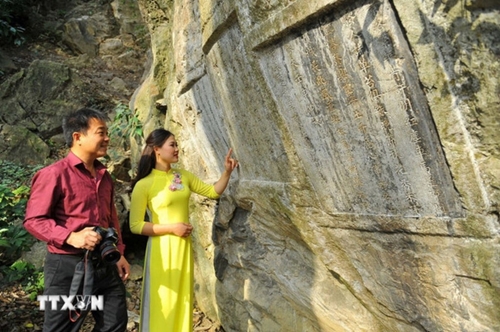The provincial authorities are currently preparing a nomination dossier for the Han-Nom inscriptions on Non Nuoc Mountain to be included in the heritage list of the UNESCO Memory of the World Committee for Asia and the Pacific (MOWCAP).
Valuable documentary heritage
The Han-Nom inscriptions, carved directly into the cliffs of the Special National Historic and Scenic Site of Non Nuoc Mountain, span from the 14th to the 20th centuries. This treasure trove of Han and Nom writing documents important historical figures and events not only in Ninh Binh but across Vietnam.
    |
 |
|
The Han-Nom inscriptions, carved directly into the cliffs of the Special National Historic and Scenic Site of Non Nuoc Mountain |
Non Nuoc Mountain is currently home to 43 cliffside stone steles (known as ma nhai, or inscriptions carved directly onto natural rock surfaces) and 12 other documents preserved through rubbings.
Among these are 37 Han-Nom texts and six in the romanized Vietnamese script (Chu Quoc ngu), dating from the Tran and Early Le dynasties (15th century), the Mac dynasty (16th century), the Le Trung Hung period (17th–18th centuries), and the Nguyen dynasty into the early 20th century. These inscriptions include royal poems, literary works, and calligraphic scripts.
According to Prof. Dr. Jing Huiling from Chaoyang University of Technology (Taiwan, China), the inscriptions are remarkable for their historical depth and literary richness, reflecting achievements in language, script, and literary style across eras. They offer a comprehensive and authentic account of the country’s past.
Besides their historical and cultural significance, the inscriptions also serve as a treasure of documentary heritage. In 2019, the Prime Minister recognized Non Nuoc Mountain as a special national relic site.
Bringing heritage to the world
Recognizing the outstanding value of the inscriptions in both content and form, Ninh Binh province is stepping up efforts in preservation, digitization, and education, using the site to promote tourism and the traditional scholarly spirit of the Vietnamese people.
Assoc. Prof., Dr. Nguyen Thi Hiep from the French Development Agency (AFD) said the site holds great potential for educational tourism, particularly through experiential learning activities for local and international students.
In the international context, the Han-Nom inscriptions on Non Nuoc Mountain may be compared with other prominent stone-document legacies such as the Republic of Korea’s steles on Namsan Mountain, ancient Egyptian rock inscriptions, or royal stelae in Ethiopia. For this reason, Ninh Binh is consulting leading experts at home and abroad to improve its nomination dossier for UNESCO recognition.
Dr. Vu Thi Minh Huong, Vice President of UNESCO’s Memory of the World Committee for Asia and the Pacific and a member of the National Cultural Heritage Council, believed the inscriptions fully meet the criteria. She noted that, aside from their content, the pieces are beautiful works of art bearing decorative patterns and imagery that mark a historical era, and showcase the development of Ninh Binh’s renowned stone-carving tradition.
Listing the Han-Nom inscriptions on Non Nuoc Mountain in the MOWCAP would not only honour a unique Vietnamese heritage but also enrich humanity’s shared historical legacy.
According to Vu Thanh Lich, Deputy Director of Ninh Binh’s Department of Culture and Sports, the department has advised the provincial People’s Committee on the implementation of conservation projects and promoting the site’s historical and scenic value. Emphasis is being placed on preserving documentary heritage, raising public awareness, fostering national pride and contributing to sustainable, culturally rich development, positioning Ninh Binh on the global tourism map.
Source: VNA